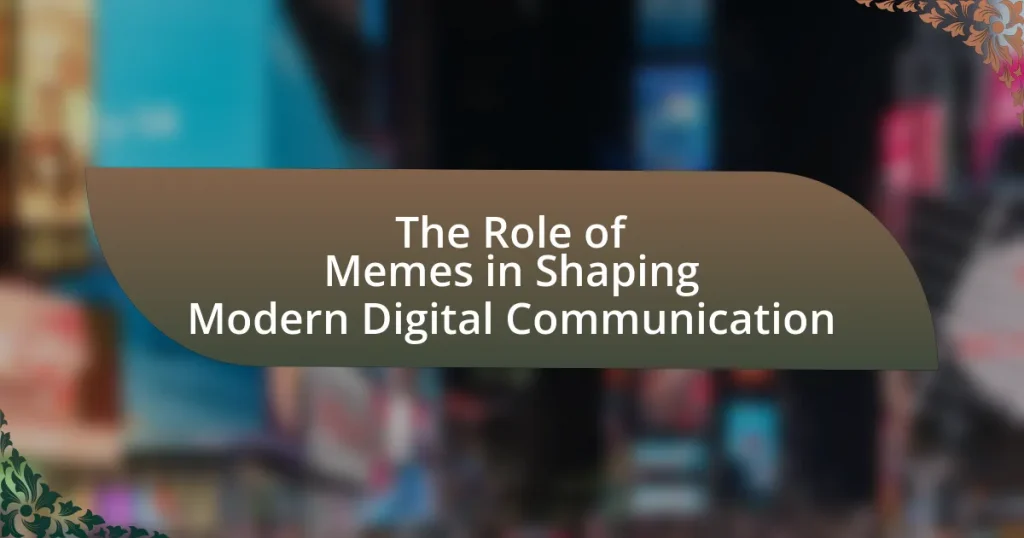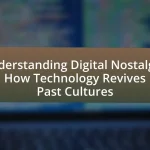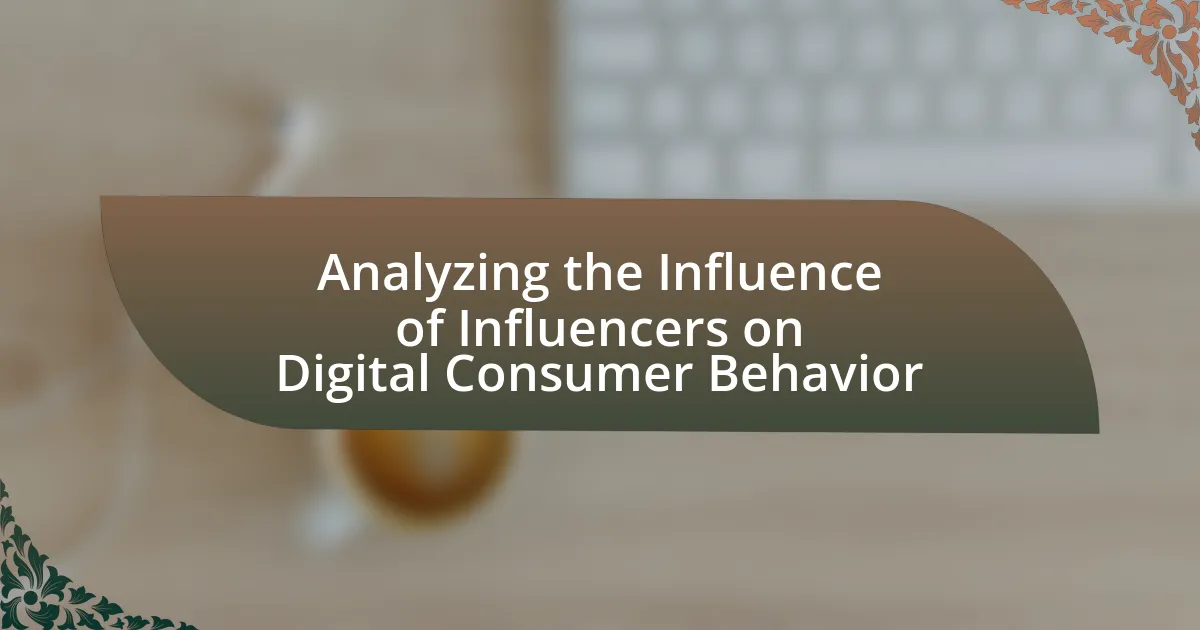Memes are a significant component of modern digital communication, serving as tools for cultural expression, social commentary, and community building. They have evolved from simple image-based jokes to complex artifacts that facilitate rapid information dissemination and engagement across various online platforms. The article explores the historical context of memes, their psychological effects on audiences, their role in shaping public opinion and political discourse, and the challenges associated with misinformation and cultural sensitivity. Additionally, it discusses best practices for effectively utilizing memes in communication and marketing strategies.
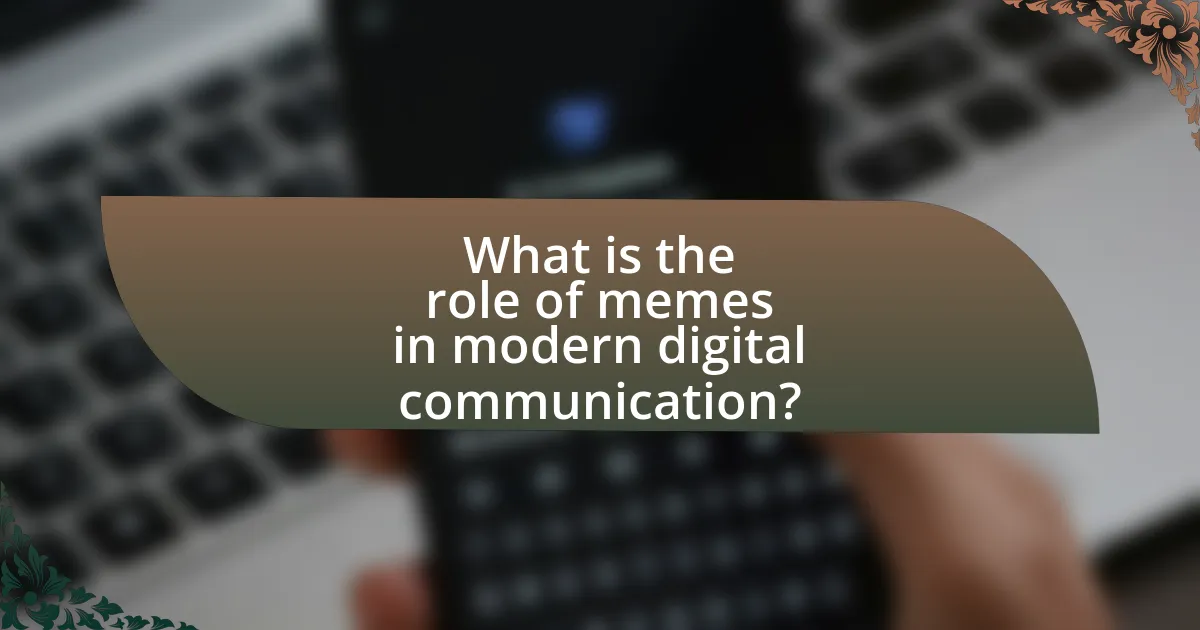
What is the role of memes in modern digital communication?
Memes play a crucial role in modern digital communication by serving as a form of cultural expression and social commentary. They facilitate the rapid dissemination of ideas, emotions, and humor across various online platforms, allowing users to connect and engage with one another. Research indicates that memes can enhance message retention and understanding, as they often combine visual elements with concise text, making complex ideas more accessible. For example, a study published in the journal “Computers in Human Behavior” found that memes significantly increase engagement on social media, demonstrating their effectiveness in capturing attention and fostering interaction.
How have memes evolved in the context of digital communication?
Memes have evolved from simple image-based jokes to complex cultural artifacts that facilitate communication and social commentary in digital spaces. Initially, memes primarily consisted of static images with text overlays, often shared on platforms like forums and social media. As digital communication advanced, memes began to incorporate video, GIFs, and interactive elements, reflecting the growing capabilities of technology and user engagement.
The rise of social media platforms, such as Twitter, Instagram, and TikTok, has further transformed memes into tools for rapid information dissemination and community building. For instance, the viral nature of memes allows for quick responses to current events, shaping public discourse and influencing opinions. Research indicates that memes can enhance emotional engagement and foster a sense of belonging among users, as seen in studies by Shifman (2014) in “Memes in Digital Culture,” which highlights their role in cultural exchange and identity formation.
Overall, memes have transitioned from mere entertainment to significant components of digital communication, serving as vehicles for expression, critique, and connection in an increasingly interconnected world.
What historical events contributed to the rise of memes?
The rise of memes can be attributed to several historical events, primarily the advent of the internet and the proliferation of social media platforms. The launch of the World Wide Web in the early 1990s enabled rapid sharing of content, while the emergence of platforms like Reddit in 2005 and Facebook in 2004 facilitated user-generated content and viral sharing. Additionally, the introduction of smartphones in the late 2000s allowed for easy access to social media, further accelerating meme dissemination. The combination of these technological advancements created an environment conducive to the rapid spread of memes, as evidenced by the viral nature of memes like “Distracted Boyfriend” and “Pepe the Frog,” which gained widespread recognition and influence in digital communication.
How do memes differ from traditional forms of communication?
Memes differ from traditional forms of communication primarily in their reliance on visual and cultural references to convey messages quickly and humorously. Unlike traditional communication, which often relies on lengthy text or formal language, memes utilize images, videos, and concise text to create relatable content that can be easily shared across digital platforms. This format allows for rapid dissemination and engagement, as evidenced by the viral nature of memes on social media, where a single image can reach millions in a matter of hours, demonstrating their effectiveness in modern communication.
Why are memes significant in shaping online interactions?
Memes are significant in shaping online interactions because they serve as a form of cultural shorthand that facilitates communication and connection among users. By encapsulating complex ideas, emotions, or social commentary in a visually engaging format, memes enable rapid sharing and understanding across diverse audiences. Research indicates that memes can enhance social bonding and community identity, as they often reflect shared experiences or humor relevant to specific groups. For instance, a study published in the journal “Computers in Human Behavior” found that memes can foster a sense of belonging and increase engagement in online communities, demonstrating their impact on social dynamics in digital spaces.
What psychological effects do memes have on audiences?
Memes have significant psychological effects on audiences, primarily influencing emotions, social behavior, and identity formation. They can evoke laughter, create a sense of belonging, and facilitate the sharing of cultural narratives, which enhances group cohesion. Research indicates that memes can also reinforce stereotypes and shape perceptions by simplifying complex ideas into easily digestible formats, as shown in studies like “The Meme as a Cultural Artifact” by Shifman (2014), which highlights how memes serve as a reflection of societal values and collective experiences. Additionally, the rapid spread of memes can lead to phenomena such as social contagion, where emotions and behaviors are transmitted through social networks, impacting public opinion and individual attitudes.
How do memes facilitate community building in digital spaces?
Memes facilitate community building in digital spaces by creating shared cultural references that foster connection among users. These humorous or relatable images and videos often encapsulate specific experiences, values, or inside jokes relevant to a particular group, enhancing a sense of belonging. For instance, platforms like Reddit and Instagram utilize memes to unite users around common interests, leading to the formation of niche communities. Research indicates that memes can enhance social interaction and engagement, as they encourage users to participate in discussions and share their interpretations, thereby reinforcing group identity and cohesion.
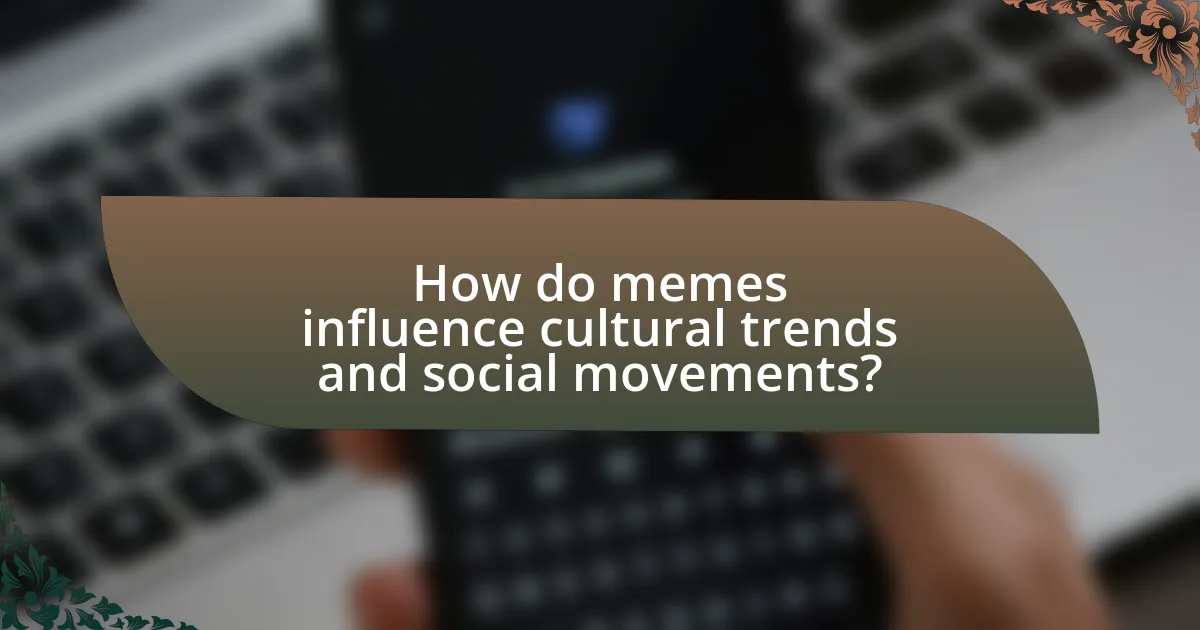
How do memes influence cultural trends and social movements?
Memes influence cultural trends and social movements by rapidly disseminating ideas and emotions, often encapsulating complex social issues in a relatable format. This viral nature allows memes to engage diverse audiences, fostering community and collective identity around shared beliefs or causes. For instance, during the Black Lives Matter movement, memes served as powerful tools for raising awareness and mobilizing support, effectively translating serious social justice messages into accessible content that resonated widely across social media platforms. Research by the Pew Research Center indicates that 55% of social media users have encountered memes related to social issues, highlighting their role in shaping public discourse and influencing perceptions.
What role do memes play in political discourse?
Memes serve as a significant tool in political discourse by facilitating the rapid dissemination of ideas and opinions. They simplify complex political messages into easily digestible formats, often using humor or satire to engage audiences. Research indicates that memes can influence public opinion and mobilize political action, as seen during events like the 2016 U.S. presidential election, where memes played a crucial role in shaping narratives on social media platforms. The viral nature of memes allows them to reach diverse demographics quickly, making them an effective means of communication in contemporary political landscapes.
How have memes been used in political campaigns?
Memes have been utilized in political campaigns as a tool for rapid dissemination of ideas and to engage younger voters. Political entities leverage memes to simplify complex issues, create relatable content, and foster a sense of community among supporters. For instance, during the 2016 U.S. presidential election, memes played a significant role in shaping public perception, with candidates like Donald Trump and Bernie Sanders effectively using meme culture to connect with audiences on platforms like Twitter and Facebook. Research indicates that memes can influence voter behavior by reinforcing existing beliefs and encouraging political participation, as seen in studies analyzing social media engagement during elections.
What impact do memes have on public opinion?
Memes significantly influence public opinion by shaping perceptions and attitudes through humor and relatability. They serve as a rapid means of communication, often simplifying complex issues into digestible content that resonates with audiences. Research indicates that memes can reinforce existing beliefs or challenge societal norms, as seen during political campaigns where memes have swayed voter sentiment. For example, during the 2016 U.S. presidential election, memes played a crucial role in shaping narratives around candidates, impacting voter engagement and opinions. This demonstrates that memes are not just entertainment; they are powerful tools in modern discourse that can mobilize public sentiment and influence collective viewpoints.
How do memes contribute to the spread of information?
Memes contribute to the spread of information by simplifying complex ideas into easily digestible formats that can be rapidly shared across social media platforms. This visual and often humorous representation allows for quick comprehension and engagement, making information more accessible to a broader audience. Research indicates that memes can enhance information retention; for instance, a study published in the journal “Computers in Human Behavior” found that humorous content significantly increases the likelihood of sharing and remembering information. Thus, memes serve as effective tools for disseminating knowledge in the digital age.
What are the advantages and disadvantages of memes as information tools?
Memes serve as effective information tools due to their ability to convey complex ideas quickly and engage audiences through humor and relatability. This rapid dissemination of information can enhance understanding and retention, as evidenced by studies showing that visual content is processed 60,000 times faster than text. However, memes also have disadvantages, including the potential for misinformation and oversimplification of nuanced topics, which can lead to misunderstandings. Research indicates that memes can distort facts, as seen in the spread of misleading memes during political campaigns, where 70% of shared political memes contained inaccuracies.
How do memes affect the virality of content online?
Memes significantly enhance the virality of content online by leveraging humor, relatability, and shareability. Their visual and concise nature allows for quick consumption and easy dissemination across social media platforms, which increases engagement rates. Research indicates that content featuring memes can achieve up to 60% higher engagement compared to non-meme content, as users are more likely to share relatable and entertaining material with their networks. This sharing behavior amplifies reach and visibility, contributing to the rapid spread of ideas and trends in digital communication.
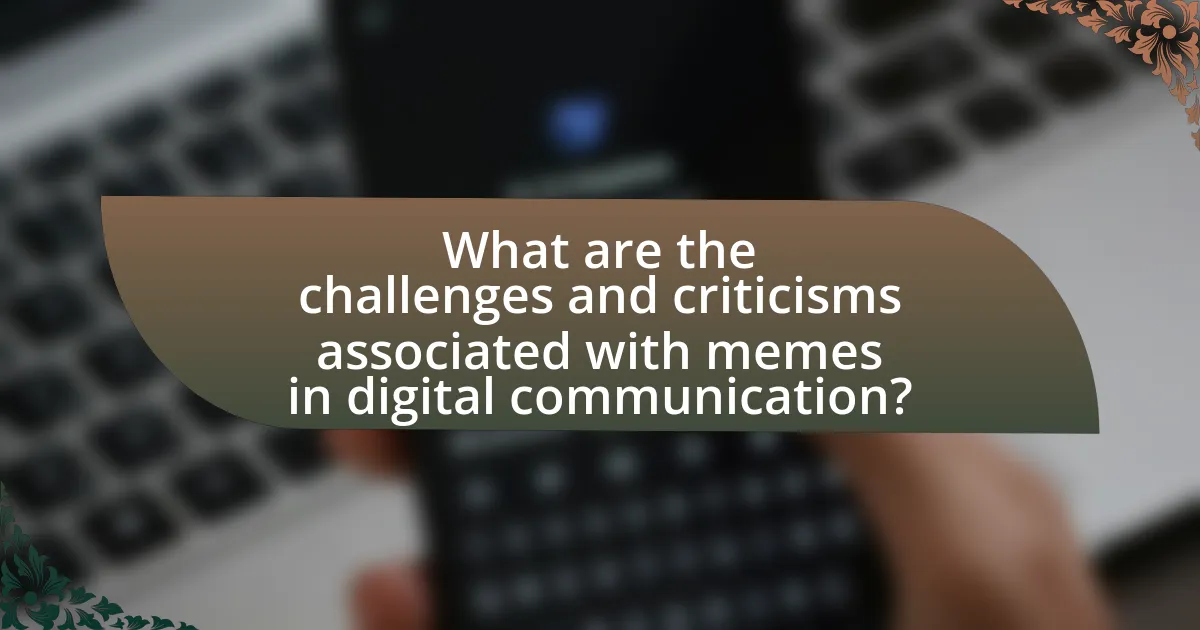
What are the challenges and criticisms associated with memes in digital communication?
Memes in digital communication face several challenges and criticisms, including the potential for misinformation, oversimplification of complex issues, and the reinforcement of stereotypes. Misinformation can spread rapidly through memes, as they often lack context and can be easily manipulated, leading to the dissemination of false narratives. Additionally, memes frequently reduce nuanced topics to simplistic images or phrases, which can hinder critical thinking and informed discourse. Furthermore, memes can perpetuate harmful stereotypes and social biases, as they often rely on cultural references that may marginalize certain groups. These challenges highlight the need for critical engagement with memes in digital communication.
What ethical concerns arise from meme usage?
Ethical concerns arising from meme usage include the potential for misinformation, cultural appropriation, and the reinforcement of harmful stereotypes. Misinformation can spread rapidly through memes, as they often simplify complex issues, leading to misunderstandings or false narratives. Cultural appropriation occurs when memes exploit cultural symbols or practices without understanding their significance, which can disrespect marginalized communities. Additionally, memes can perpetuate harmful stereotypes by trivializing serious issues or misrepresenting groups, contributing to societal biases. These concerns highlight the need for critical engagement with meme content in digital communication.
How can memes perpetuate misinformation?
Memes can perpetuate misinformation by simplifying complex issues into easily digestible images or phrases that often lack context. This oversimplification can lead to the spread of false narratives, as users may share memes without verifying the accuracy of the information presented. Research indicates that memes can influence public perception and beliefs, as they are often designed to evoke emotional responses, making them more shareable and memorable. For example, a study published in the journal “Computers in Human Behavior” found that emotionally charged memes are more likely to be shared, which can amplify misleading information across social media platforms.
What are the implications of meme culture on mental health?
Meme culture has significant implications on mental health, influencing both positive and negative aspects. On one hand, memes can foster a sense of community and belonging, providing individuals with humor and relatability that can alleviate feelings of isolation. For instance, a study published in the journal “Computers in Human Behavior” found that sharing memes can enhance social connections and improve mood among users. On the other hand, meme culture can also contribute to negative mental health outcomes, such as anxiety and depression, particularly when memes perpetuate harmful stereotypes or promote unrealistic standards. Research from the “Journal of Social and Clinical Psychology” indicates that exposure to negative memes can exacerbate feelings of inadequacy and low self-esteem. Thus, the dual nature of meme culture highlights its complex role in shaping mental health outcomes in the digital age.
How can individuals and organizations effectively use memes?
Individuals and organizations can effectively use memes by creating relatable and shareable content that resonates with their target audience. Memes leverage humor, cultural references, and visual appeal to engage users, making them a powerful tool for communication and marketing. For instance, brands like Wendy’s have successfully utilized memes on social media to enhance their brand personality and connect with younger demographics, resulting in increased engagement and brand loyalty. Research indicates that content that incorporates humor and relatability can lead to higher sharing rates, with studies showing that humorous posts can increase engagement by up to 50%.
What best practices should be followed when creating memes for communication?
When creating memes for communication, it is essential to ensure clarity, relevance, and cultural sensitivity. Clarity involves using easily understandable language and visuals that convey the intended message without ambiguity. Relevance requires that the meme aligns with the audience’s interests and current trends, enhancing engagement and relatability. Cultural sensitivity is crucial to avoid offending or alienating any group, as memes often reflect societal norms and values.
Research indicates that memes that resonate with the audience’s experiences and emotions are more likely to be shared and understood, thus amplifying their communicative effectiveness. For instance, a study published in the journal “Computers in Human Behavior” found that memes that evoke humor and familiarity significantly increase user engagement on social media platforms.
How can memes be leveraged for marketing and branding purposes?
Memes can be leveraged for marketing and branding purposes by creating relatable and shareable content that resonates with target audiences. This approach enhances brand visibility and engagement, as memes often go viral, reaching a wider audience quickly. For instance, brands like Wendy’s have successfully used memes to engage with younger demographics, resulting in increased social media interactions and brand loyalty. According to a study by the Digital Marketing Institute, 72% of marketers believe that memes are effective in increasing brand awareness, demonstrating their potential impact in modern digital communication.
